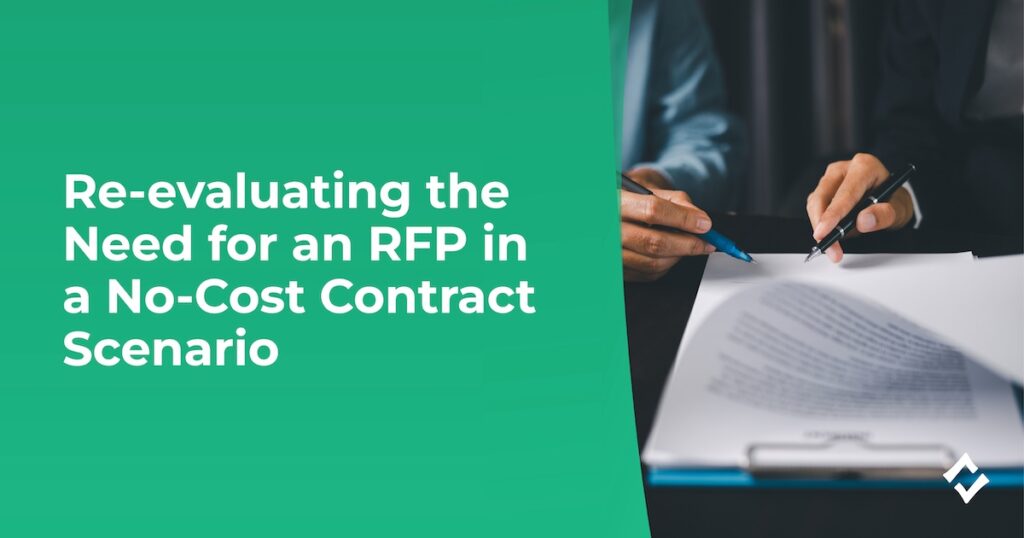By Kelly Parker, Sr. Director of External Affairs and Government Relations, CE Broker by Propelus
For state regulatory boards, the Request for Proposal (RFP) process has long been the go-to method for sourcing products and services—especially when managing taxpayer funds. But what happens when there’s no money involved? If a contract is valued at $0, does an RFP still make sense in state government contracting processes?
The short answer: Not always. In many cases, prioritizing relationships, trust, and operational efficiency over formal procedures (“red tape”) can often lead to better outcomes.
Let’s break it down.
Why an RFP Might Not Make Sense for a $0 Contract
The RFP process is designed to promote fairness, transparency, and competitive pricing. That makes perfect sense when a government agency is spending taxpayer dollars. But when no money is being exchanged, the same level of formality isn’t always necessary and can introduce unnecessary complexities.
Here’s why:
- It slows everything down. Drafting an RFP, collecting bids, reviewing submissions, and negotiating terms can take months and extend implementation times. That’s valuable time wasted, especially in time-sensitive situations like renewal cycles.
- It creates extra work for no reason. Procurement teams and regulatory boards already have heavy workloads. Imposing unnecessary administrative burdens through lengthy RFP processes diverts valuable resources from core responsibilities.
- It limits flexibility. RFPs often impose rigid requirements, limiting an agency’s ability to adapt to evolving needs and technological advancements.
The Smarter Alternative: Trust-Based Partnerships
When cost isn’t a factor, selecting a partner should be about trust, expertise, and alignment with long-term goals. Instead of issuing an RFP for a $0 contract, agencies should consider working directly with organizations that:
- Have a proven track record. Experience matters. Vendors with a history of successfully working with regulatory boards bring insights and solutions that can’t be replicated by newcomers.
- Understand the mission. The best partners aren’t just vendors; they’re partners who are invested in the agency’s success.
- Offer long-term stability. Instead of being locked into a short-term contract based on an RFP cycle, agencies can work with trusted providers that offer consistent support and innovation.
Take CE Broker by Propelus, for example. CE Broker provides a continuing education management solution at no cost to regulatory boards. Because there’s no financial transaction, many states skip the RFP process altogether and engage directly.
It’s a faster, smarter way to implement a system that benefits both agencies and the professionals they regulate.
Faster, More Efficient Procurement Options
A lengthy RFP process isn’t the only way to establish a vendor relationship. State agencies can leverage alternative procurement methods to expedite implementation while maintaining compliance and transparency. Those include the following.
1. Sole Source Justification or Request for Waiver
If only one provider meets the agency’s needs—particularly for a $0 contract—it may qualify as a sole source procurement. Many states permit this with the appropriate documentation, bypassing the need for an RFP. Additionally, in some states, boards can request a waiver from the IT department to contract for no-cost technology without requiring an RFP
2. Memorandum of Understanding (MOU)
An MOU is a simple, legally non-binding agreement that formalizes a working relationship between two entities. It’s a great way to establish expectations without the complexities of an RFP.
3. Unilateral Right to Purchase
Some state agencies have the authority to contract directly with vendors if the service falls within their scope of operations. This allows them to implement solutions quickly and efficiently without all of the red tape.
Transparency and Trust Without an RFP
One of the main arguments for an RFP is that it ensures transparency. But transparency doesn’t come from a complex procurement process. It comes from clear expectations, open communication, and strong accountability measures.
Agencies can maintain high ethical standards without an RFP by:
- Setting clear deliverables and success metrics at the start of the partnership to ensure alignment and accountability.
- Holding vendors accountable through regular check-ins and performance reviews.
- Keeping decision-making processes open and documented for public trust and transparency.
The Bottom Line: Not Every Contract Needs an RFP
While RFPs remain a valuable tool for certain transactions, they’re not always necessary. When no money is changing hands, agencies should rethink whether an RFP is worth the time, effort, and resources.
For regulatory boards considering other options, the focus should be on partnership, trust, and efficiency rather than defaulting to the traditional RFP process.
Next Steps
If you’re in a leadership or procurement role, talk to your legal team about your state’s procurement rules.
Many states allow for sole source justifications, waivers or MOUs, which could save you months of unnecessary paperwork.
Additionally, consider the benefits of direct engagement with trusted partners to expedite implementation and enhance operational efficiency.
The goal should always be to find the best solution as quickly and efficiently as possible—without getting tangled in red tape.
Check out the CE Broker RFP Guide, for more information on how to streamline this process.

